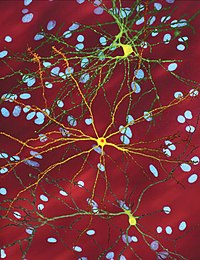
Photo from wikipedia
Purpose: Due to the variety of clinical symptoms that occur in rare neurodegenerative diseases and difficulties in the correct diagnosis, there is a need to learn their characteristic imaging findings… Click to show full abstract
Purpose: Due to the variety of clinical symptoms that occur in rare neurodegenerative diseases and difficulties in the correct diagnosis, there is a need to learn their characteristic imaging findings by using conventional MRI. That knowledge helps to determine the appropriate differential diagnosis and avoid misdiagnosis. The aim of this review is to present the typical neuroimaging signs of the selected neurodegenerative disorders and to create a practical approach to imaging findings useful in everyday clinical practice. Images: Images of progressive supranuclear palsy (PSP), multiple system atrophy (MSA), corticobasal degeneration (CBD), Creutzfeldt-Jakob disease (CJD), Wilson’s disease (WD), and cerebral autosomal dominant arteriopathy with subcortical infarcts and leukoencephalopathy (CADASIL) are provided to visualize and distinguish the typical features of those diseases and therefore to assist neurologists and neuroradiologists in decision-making process. Conclusions: It is important to know the characteristic MRI features of rare neurodegenerative diseases and to use them in everyday clinical practice. MRI is a valuable tool when considering the initial diagnosis because it is proven to be very useful in the differentiation of more advanced stages of the rare neurodegenerative diseases but also from other neurodegenerative disorders.
Journal Title: Dementia and Geriatric Cognitive Disorders
Year Published: 2020
Link to full text (if available)
Share on Social Media: Sign Up to like & get
recommendations!